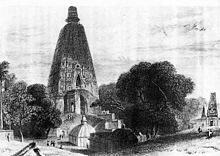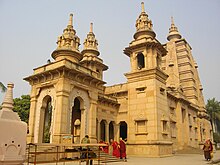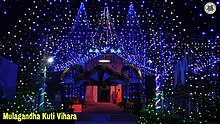Maha Bodhi Society
| Part ofa serieson |
| Buddhism |
|---|
 |
TheMaha Bodhi Societyis aSouth AsianBuddhistsociety presently based inKolkata,India.Founded by theSri LankanBuddhist leaderAnagarika Dharmapalaand the British journalist and poet SirEdwin Arnold,its first office was inBodh Gaya.The organization's efforts began in order to resuscitate Buddhism in India, and to restore the ancient Buddhist shrines atBodh Gaya,SarnathandKushinara.The restoration and revival of the glory and sanctity of Bodh Gaya are also aims of Maha Bodhi Society.[1][2][3][4]


Although many Indians had remained culturally Buddhist for centuries after thedecline of Buddhism,they did not self-identify as "Buddhist".[citation needed]The Maha Bodhi Society renewed interest in Buddhism, and spawned theLadakh Buddhist Association,All Assam Buddhist Association,andHimalayan Buddhist Society,as well as laying the grounds for theDalit Buddhist movement.[5]

Origins[edit]
In 1891, while onpilgrimageto the recently restoredMahabodhi TempleatBodh Gaya,the location whereSiddhartha Gautama(the Buddha) attainedenlightenment,Anagarika Dharmapala had experienced a shock to find the temple in the hands of aSaivitepriest, the Buddha image transformed into aHinduicon and Buddhists barred from worship. As a result, he began an agitation movement.[6]Prior to that, in 1885 SirEdwin Arnoldvisited the site and published several articles drawing the attention of the Buddhists to the deplorable conditions of Bodh Gaya.[2][3][4]The Buddhist renaissance inaugurated by Anagarika Dharmapala through his Mahabodhi Movement has also been described as "conservative" for it consideredMuslim conquest in the Indian subcontinentresponsible for the decay ofBuddhism in India,in the then current mood of Hindu-Buddhist brotherhood.[7]

The Mahabodhi Society atColombowas founded in 1891 but its offices were moved toCalcuttathe following year. One of its primary aims was the restoration of theMahabodhi TempleatBodh Gaya,the chief of the four ancient Holy sites to Buddhist control.[8][9]To accomplish this Dharmapala initiated a lawsuit against theBrahminpriests who had held control of the site for centuries.[8][9]After a protracted struggle this was successful with the partial restoration of the site to the management of the Maha Bodhi Society in 1949.[8][9]
Maha Bodhi Society branches have been established in several countries, most significantly in India and Sri Lanka. AUnited Statesbranch was founded by Dr.Paul CarusinChicago.[10]
TheMahā Bodhī Society of Beṅgaḷūru,founded byBuddharakkhitaĀcariyain 1956, is a sister organization that functions and is administered independently.
The Mahabodhi Temple[edit]

After the defeat of the Palas by the Hindu Sena dynasty, Buddhism's position again began to erode and was soon followed by the conquest of Magadha by GeneralIkhtiar Uddin Muhammad Bin Bakhtiyar Khilji.[11]During this period, the Mahabodhi Temple fell into disrepair and was largely abandoned. During the 16th century, aHindumonastery was established near Bodh Gaya. Over the following centuries, the monastery's abbot ormahantbecame the area's primary landholder and claimed ownership of the Mahabodhi Temple grounds.
In the 1880s, the then-British government of India began to restore Mahabodhi Temple under the direction of SirAlexander Cunningham.In 1885, SirEdwin Arnoldvisited the site and published several articles drawing the attention of the Buddhists to the deplorable conditions of Buddhagaya.[2]He was guided in this undertaking by Ven.Weligama Sri Sumangala.[3][4]In 1891,Anagarika Dharmapalastarted a campaign to return control of the temple to Buddhists, over the objections of themahant.The campaign was partially successful in 1949, when control passed from the Hindu mahant to the state government of Bihar, which established a temple management committee. The committee has nine members, a majority of whom, including the chairman, must by law be Hindus. Mahabodhi's first head monk under the management committee wasAnagarika Munindra,aBengaliman who had been an active member of the Maha Bodhi Society.
Mulagandha Kuty Vihara in Sarnath[edit]


Mulagandha Kuty Vihara inSarnathis a fitting reminder of Sarnath's past glory. It is also the crowning and most glorious achievement of Anagarika Dharmapala's lifelong dedication. The construction of the Mulagandha Kuty Vihara was taken up byAnagarika Dharmapalain 1926, towards the end of his pious life. When he decided to construct a temple atSarnathand after making the architectural plans, his generous Hawaiian patron,Mary Robinson Foster,donated the first financial assistance that came from her parents, brother and well-wishers.Anagarika Dharmapalapersonally supervised the constructional works. The 200 feet high magnificent temple was opened to public in 1931. Later a reputed Japanese artist Kosetsu Nosu (1885- 1973)[12]and his assistant undertook the task to decorate the temple walls with fresco paintings famously as the Mural paintings of Mulagandha Kuty Vihara, depicting the life events of Sakyamuni Buddha. On the opening day of the Vihara, the Buddha's relics donated to Anagarika Dharmapala by Govt. of India under the British Raj was enshrined in the temple. The Vihara, an attractive place of Buddhist worship was visited by numerous Indian and foreign dignitaries and millions of pilgrims and tourists over the past decades. At the Mulagandha Kuty Vihara annual function in November, the most attractive item among the programs is the exposition of the Buddha's sacred relic. People from different countries and from the homeland visit the Vihara to homage to the sacred relic considering it as a rare and an opportune moment in their lifetime.

Publications[edit]
The Maha Bodhi Society has a robust tradition of publications, spanning fromPalitranslations into modern Indian vernacular languages (such asHindi) to scholarly texts and new editions of Pali works typeset inDevanagarito appeal to a Hindi-educated Indian audience. They have also published books and pamphlets in local/regional languages and dialects, sometimes in partnership with other presses.
Leadership[edit]

Most Venerable P Seewalee Thero is serving as the 12th and current General Secretary of the Maha Bodhi Society of India since 2016 and the Joint Secretaries are Venerable Kahatagollawe Medhankara Thero and Ven. Rathmalwa Sumithananda Thero.
At a meeting in September 2008, the Maha Bodhi Society passed a rule that only persons born into Buddhist families will be eligible to serve as president or as one of the vice-presidents of the Society. The outgoing president,B. K. Modi,aHindu,assumed the position of patron. At the same meeting, the14th Dalai Lamawas given the new title of chief patron.[13]
See also[edit]
- Acharya Buddharakkhita
- Anagarika Munindra
- Hammalawa Saddhatissa
- London Buddhist Vihara
- Sri Lanka Maha Bodhi Centre, Chennai
- Buddhism in India
References[edit]
- ^"Welcome to Maha Bodhi Society of India".Mahabodhi Society of India.28 July 2011.Archivedfrom the original on 9 January 2013.
- ^abc[<-- non working ref -->http://mahabodhisociety.com/Maha Bodhi Society]
- ^abcArnold, Edwin (1906).India Revisited,London: K. Paul, Trench, Trübner
- ^abcDipak K. Barua (1981). “Buddha Gaya Temple: its history”, Buddha Gaya: Buddha Gaya Temple Management Committee
- ^D.C. Ahir.Buddhism in Modern India.Delhi: Sri Satguru Publications, 1991. p. 17.
- ^Sean O'Reilly, James O'Reilly,Pilgrimage: Adventures of the Spirit,Travelers' Tales, 2000,ISBN1-885211-56-2pg 81-82
- ^A Close View of Encounter between British Burma and British Bengal
- ^abcArnold Wright,Twentieth Century Impressions of Ceylon: its history, people, commerce, industries, and resources,"Angarika Dharmapala", Asian Educational Services, 1999,ISBN81-206-1335-Xpg.119
- ^abcC. J. Bleeker, G. Widengren,Historia Religionum, Volume 2 Religions of the Present: Handbook for the History of Religions,Brill Academic Publishers, 1971,ISBN90-04-02598-7pg. 453
- ^Linda Learman, ed. (2005).Buddhist Missionaries in the Era of Globalizationa.University of Hawai'i Press. p. 33.ISBN0-8248-2810-0.Retrieved17 June2017.
- ^The Maha-Bodhi By Maha Bodhi Society, Calcutta (page 205).
- ^Kosetsu Nosu: The Japanese Artist who Painted at Sarnath, Satyasri Ukil,
- ^Sengupta, Ratnottama (September 28, 2008).Now, Hindus can't head Mahabodhi SocietyTimes of India
